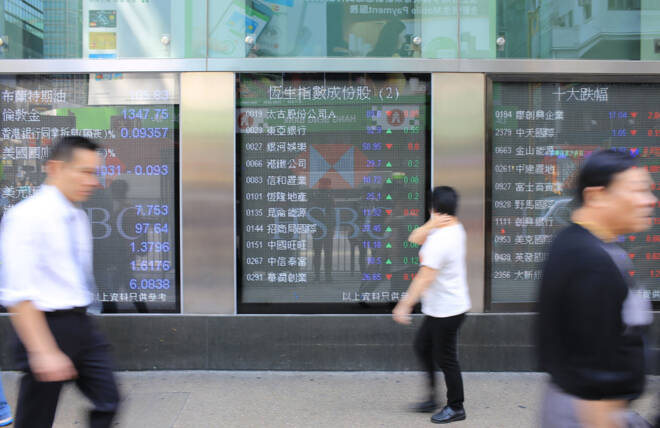Advertisement
Advertisement
Hang Seng Index, ASX 200, Nikkei 225: US Economic Indicators and PMIs Shape Thursday Session
By:
Thursday's US indicators may sway Asian markets. Labor market and consumer sentiment challenge May Fed rate hike forecasts.
Highlights
- The Hang Seng Index ended the Wednesday session flat, while the ASX 200 and Nikkei moved in opposite directions.
- The FOMC Meeting Minutes impacted the appetite for riskier assets on Wednesday.
- Overnight US economic indicators and Australian private sector PMIs to set the tone for the Thursday session.
Overview of the Wednesday Session
On Wednesday, the ASX 200 ended the session in negative territory, while the Nikkei made gains. The Hang Seng Index ended the session flat.
The overnight FOMC Meeting Minutes from Tuesday tested the appetite for riskier assets. The minutes revealed a Fed committed to raising interest rates should inflationary pressures resurface. The minutes were a reminder that the battle against inflation was far from over.
The US equity markets set the tone for the Asian session on Wednesday. On Tuesday, the Nasdaq Composite Index declined by 0.59%, with the Dow and S&P 500 falling by 0.18% and 0.20%, respectively.
There were no Asian economic indicators to influence investor risk sentiment on Wednesday. However, a stronger USD/JPY supported the Nikkei.
US Jobless Claims and Consumer Sentiment to Influence Thursday
On Thursday, overnight US economic indicators could set the tone for the Asian session on Friday. Labor market and consumer sentiment figures questioned bets on a May Fed rate cut. Tight labor market conditions support wage growth and consumer spending. An upward trend in consumer spending would fuel demand-driven inflation, forcing the Fed to keep a hawkish rate path. 10-year US Treasury yields ended the session up 0.30%.
On Wednesday, the Dow and S&P 500 rose by 0.53% and 0.41%, with the Nasdaq Composite Index gaining 0.46%.
The Asian economic calendar warrants consideration on Thursday. Prelim private sector PMIs for Australia could move the dial. Weaker-than-expected PMIs amid uncertainty about the Chinese economy will test buyer demand for ASX 200-listed stocks.
The Judo Bank Manufacturing PMI fell from 48.2 to 47.7, with the Services PMI down from 47.9 to 46.3. A marked decline in the services PMI raises the threat of a recession. The Australian services sector contributes over 60% to the economy.
In the futures markets, the ASX 200 was down 27 points on Thursday. The Japanese markets are closed on Thursday for Labor Thanksgiving Day.
ASX 200
The ASX 200 slipped by 0.07% on Wednesday. Tech stocks dragged the ASX 200 into negative territory. The S&P ASX All Technology Index (XTX) declined by 0.94%. NVIDIA (NVDA) forward guidance on the outlook for China weighed on tech stocks. However, banks and mining stocks cushioned the downside.
BHP Group Ltd (BHP) and Rio Tinto Ltd. (RIO) rose by 0.93% and 0.31%, while Fortescue Metals Group Ltd. (FMG) fell by 0.12%.
Gold stocks also had a mixed session. Evolution Mining Ltd. (EVN) fell by 0.26%, while Northern Star Resources Ltd. (NST) gained 0.25%.
Bank stocks provided support despite a mixed Wednesday session. ANZ Group Holdings Ltd (ANZ) gained 0.21%, with Commonwealth Bank of Australia (CBA) and National Australia Bank Ltd. (NAB) rising by 0.10% and 0.14%. Westpac Banking Corp. (WBC) bucked the trend, falling 0.28%.
However, oil stocks had a positive Wednesday session. Woodside Energy Group Ltd (WDS) and Santos Ltd (STO) ended the session up 0.28% and 0.71%.
Hang Seng Index
The Hang Seng Index ended the Wednesday session flat. Property stocks saw gains, with the Hang Seng Properties Index (HSMPI) rising by 1.00%. However, market euphoria over Fed monetary policy faded, with uncertainty about the Chinese economy leaving the Index flat.
Alibaba (9988) gained 1.05%, while Tencent (0700) fell by 0.12%.
Bank stocks also had a mixed session. HSCB (0005) declined by 0.33%. China Construction Bank (0939) gained 0.22%, while Industrial and Commercial Bank (1398) ended the session flat.
The Nikkei 225
The Nikkei 225 gained 0.29% on Wednesday. A stronger USD/JPY supported export stocks.
(Graph for reference purposes only)
Sumitomo Mitsui Financial Group (8316) and Mitsubishi UFJ Financial Group (8306) ended the day with gains of 0.24% and 0.76%. However, it was another mixed session for the main components of the Nikkei.
Fast Retailing (9983) rallied by 1.26%, with Sony Corp (6758) and KIDDI Corp. (9433) rising by 0.93% and 0.96%, respectively.
Tokyo Electron (8035) and Softbank (9984) saw losses of 0.93% and 0.27%.
For upcoming economic events, check out our economic calendar.
About the Author
Bob Masonauthor
With over 28 years of experience in the financial industry, Bob has worked with various global rating agencies and multinational banks. Currently he is covering currencies, commodities, alternative asset classes and global equities, focusing mostly on European and Asian markets.
Advertisement
